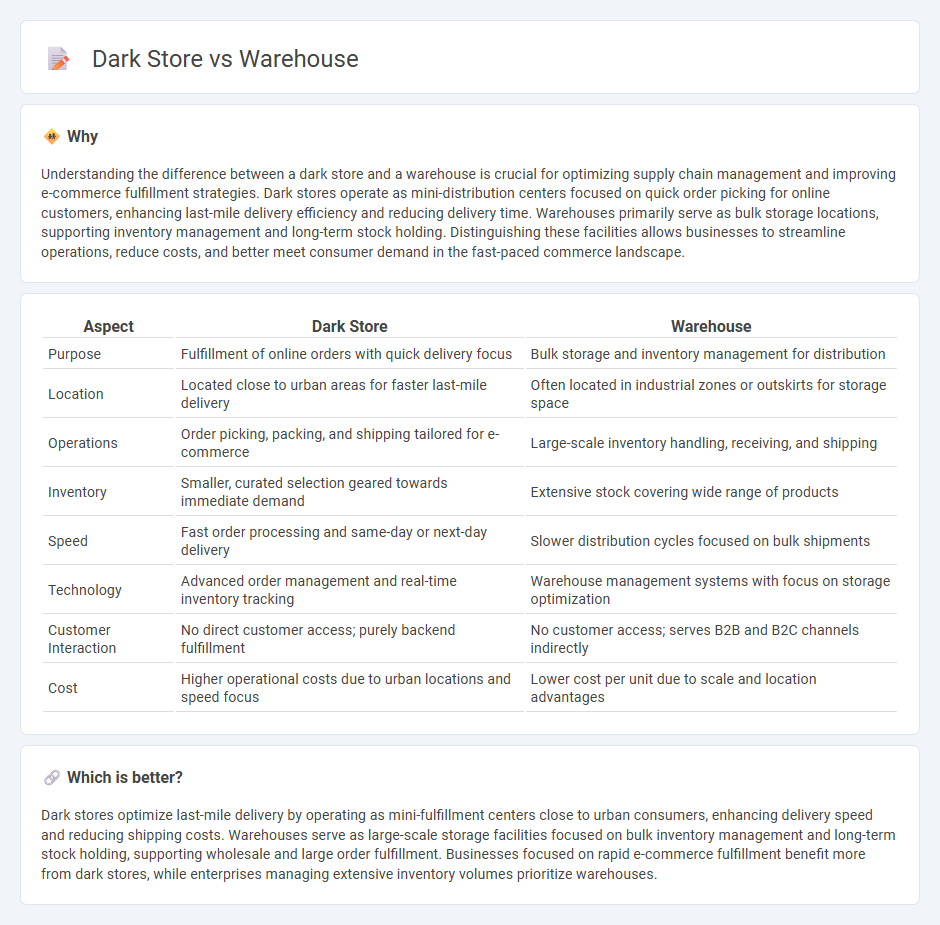
Dark stores serve as local fulfillment centers designed specifically for online order processing and rapid delivery, optimizing last-mile logistics in e-commerce. Warehouses focus on bulk storage and inventory management, supporting large-scale distribution across regions. Explore how choosing between dark stores and warehouses can enhance your retail supply chain strategy.
Why it is important
Understanding the difference between a dark store and a warehouse is crucial for optimizing supply chain management and improving e-commerce fulfillment strategies. Dark stores operate as mini-distribution centers focused on quick order picking for online customers, enhancing last-mile delivery efficiency and reducing delivery time. Warehouses primarily serve as bulk storage locations, supporting inventory management and long-term stock holding. Distinguishing these facilities allows businesses to streamline operations, reduce costs, and better meet consumer demand in the fast-paced commerce landscape.
Comparison Table
| Aspect | Dark Store | Warehouse |
|---|---|---|
| Purpose | Fulfillment of online orders with quick delivery focus | Bulk storage and inventory management for distribution |
| Location | Located close to urban areas for faster last-mile delivery | Often located in industrial zones or outskirts for storage space |
| Operations | Order picking, packing, and shipping tailored for e-commerce | Large-scale inventory handling, receiving, and shipping |
| Inventory | Smaller, curated selection geared towards immediate demand | Extensive stock covering wide range of products |
| Speed | Fast order processing and same-day or next-day delivery | Slower distribution cycles focused on bulk shipments |
| Technology | Advanced order management and real-time inventory tracking | Warehouse management systems with focus on storage optimization |
| Customer Interaction | No direct customer access; purely backend fulfillment | No customer access; serves B2B and B2C channels indirectly |
| Cost | Higher operational costs due to urban locations and speed focus | Lower cost per unit due to scale and location advantages |
Which is better?
Dark stores optimize last-mile delivery by operating as mini-fulfillment centers close to urban consumers, enhancing delivery speed and reducing shipping costs. Warehouses serve as large-scale storage facilities focused on bulk inventory management and long-term stock holding, supporting wholesale and large order fulfillment. Businesses focused on rapid e-commerce fulfillment benefit more from dark stores, while enterprises managing extensive inventory volumes prioritize warehouses.
Connection
Dark stores function as localized warehouses designed for rapid order fulfillment, bridging the gap between traditional warehouses and retail storefronts. Both serve as pivotal nodes in the supply chain, with dark stores optimized for e-commerce and last-mile delivery efficiency, while warehouses focus on bulk storage and inventory management. This integration enhances overall commerce operations by accelerating delivery times and improving inventory accuracy.
Key Terms
Inventory Management
Warehouse inventory management prioritizes bulk storage, efficient stock rotation, and long-term supply chain optimization to ensure large product availability. Dark stores emphasize real-time inventory tracking, rapid replenishment, and precise item picking to meet immediate consumer demand from e-commerce orders. Explore in-depth strategies and technologies enhancing inventory control in both environments for optimized operations.
Order Fulfillment
Warehouses primarily function as large storage facilities designed to hold inventory for bulk distribution, optimizing space and inventory management for long-term storage. Dark stores operate as localized micro-fulfillment centers focused on rapid order picking and delivery, especially for e-commerce and same-day delivery services. Explore the key differences in order fulfillment strategies between warehouses and dark stores to enhance your supply chain efficiency.
Distribution Channel
Warehouses serve as centralized storage facilities facilitating bulk inventory management and long-term stockpiling within traditional distribution channels, optimizing supply chain efficiency. Dark stores function as localized fulfillment centers designed specifically for rapid order processing and last-mile delivery in e-commerce and omnichannel retail strategies. Explore the detailed differences to enhance your distribution channel optimization strategy.
Source and External Links
Warehouse - Wikipedia - A warehouse is a building for storing goods used by manufacturers, importers, exporters, wholesalers, and others, usually equipped with loading docks and designed for efficient storage and movement of goods.
What is a Warehouse? Definition and Meaning | Sage Advice US - A warehouse is a commercial space essential to the supply chain, used to store finished goods and raw materials, and often synonymous with distribution centers.
What is a warehouse? Our definition - Interlake Mecalux - Warehouses consist of storage racks, handling equipment, offices, and specialized areas like reception, packaging, and dispatch, organized to facilitate storage and movement of diverse goods.
 dowidth.com
dowidth.com